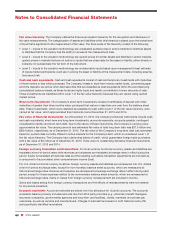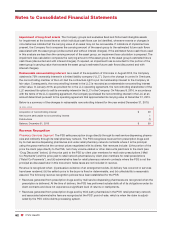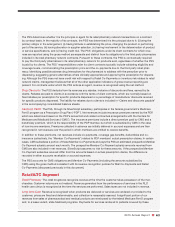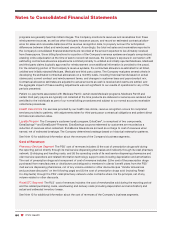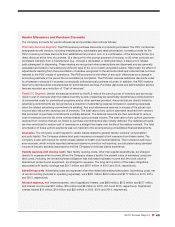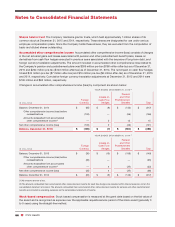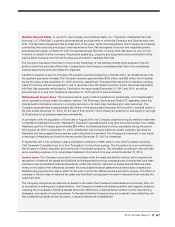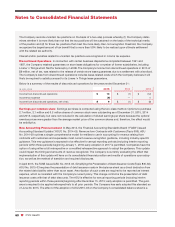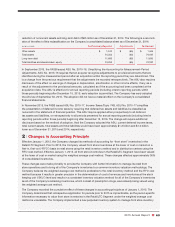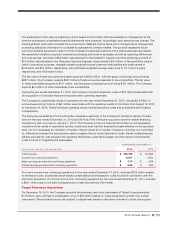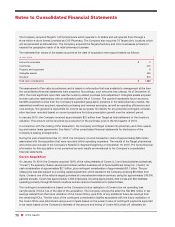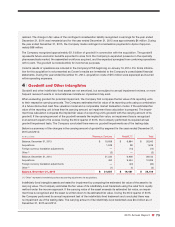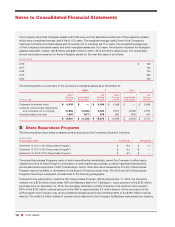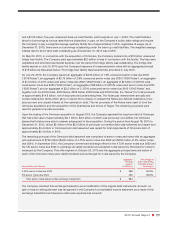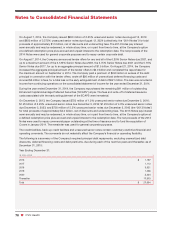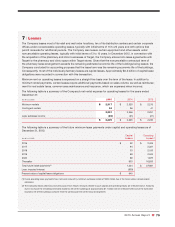CVS 2015 Annual Report Download - page 71
Download and view the complete annual report
Please find page 71 of the 2015 CVS annual report below. You can navigate through the pages in the report by either clicking on the pages listed below, or by using the keyword search tool below to find specific information within the annual report.
69
2015 Annual Report
reduction of noncurrent assets and long-term debt of $65 million as of December 31, 2014. The following is a reconcili-
ation of the effect of this reclassification on the Company’s consolidated balance sheet as of December 31, 2014:
IN MILLIONS As Previously Reported Adjustments As Revised
Other assets $ 1,510 $ (65) $ 1,445
Total assets 74,252 (65) 74,187
Long-term debt 11,695 (65) 11,630
Total liabilities and shareholders’ equity 74,252 (65) 74,187
In September 2015, the FASB issued ASU No. 2015-16,
Simplifying the Accounting for Measurement-Period
Adjustments
. ASU No. 2015-16 requires that an acquirer recognize adjustments to provisional amounts that are
identified during the measurement period after an acquisition within the reporting period they are determined. This
is a change from the previous requirement that the adjustments be recorded retrospectively. The ASU also requires
disclosure of the effect on earnings of changes in depreciation, amortization or other income effects, if any, as a
result of the adjustment to the provisional amounts, calculated as if the accounting had been completed at the
acquisition date. The ASU is effective for annual reporting periods (including interim reporting periods within
those periods) beginning after December 15, 2015; early adoption is permitted. The Company has early adopted
the ASU as of September 30, 2015. The adoption did not have a material effect on the Company’s consolidated
financial statements.
In November 2015, the FASB issued ASU No. 2015-17,
Income Taxes (Topic 740)
. ASU No. 2015-17 simplifies
the presentation of deferred income taxes by requiring that deferred tax assets and liabilities be classified as
nocurrent in the statement of financial position. This ASU may be applied either prospectively to all deferred
tax assets and liabilities, or retrospectively to all periods presented for annual reporting periods (including interim
reporting periods within those periods) beginning after December 15, 2016. The change will require additional
disclosure based on the method of adoption. Had the Company adopted this ASU, current deferred income taxes,
total current assets, total assets and total liabilities would have been approximately $1.2 billion and $1.0 billion
lower as of December 31, 2015 and 2014, respectively.
2 | Changes in Accounting Principle
Effective January 1, 2015, the Company changed its methods of accounting for “front store” inventories in the
Retail/LTC Segment. Prior to 2015, the Company valued front store inventories at the lower of cost or market on a
first-in, first-out (“FIFO”) basis in retail stores using the retail inventory method and in distribution centers using the
FIFO cost method. Effective January 1, 2015, all front store inventories in the Retail/LTC Segment have been valued
at the lower of cost or market using the weighted average cost method. These changes affected approximately 36%
of consolidated inventories.
These changes were made primarily to provide the Company with better information to manage its retail front
store operations and to bring all of the Company’s inventories to a common inventory valuation methodology. The
Company believes the weighted average cost method is preferable to the retail inventory method and the FIFO cost
method because it results in greater precision in the determination of cost of revenues and inventories at the stock
keeping unit (“SKU”) level and results in a consistent inventory valuation method for all of the Company’s inventories
as all of the Company’s remaining inventories, which consist of prescription drugs, were already being valued using
the weighted average cost method.
The Company recorded the cumulative effect of these changes in accounting principle as of January 1, 2015. The
Company determined that retrospective application for periods prior to 2015 is impracticable, as the period-specific
information necessary to value front store inventories in the Retail/LTC Segment under the weighted average cost
method is unavailable. The Company implemented a new perpetual inventory system to manage front store inventory



